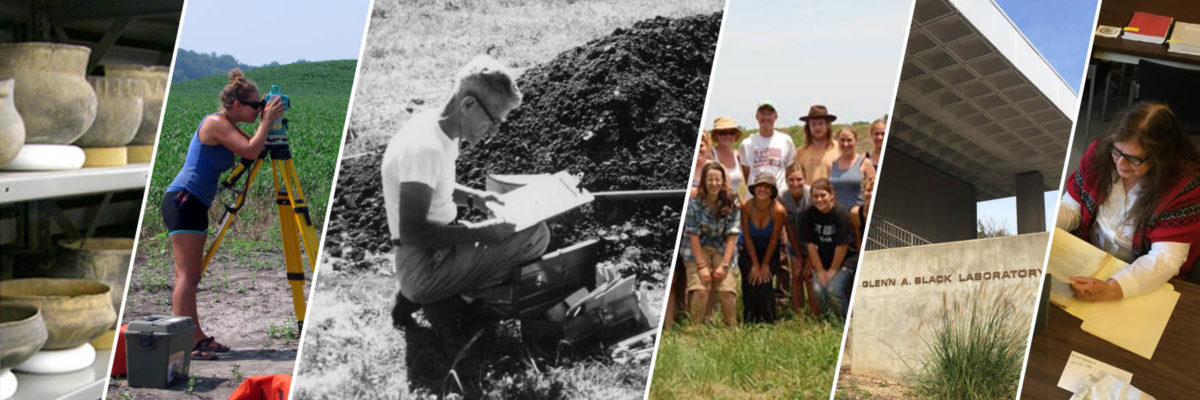September 23, 2016
by Hannah Rea, Social Media Intern
The screen at the front of the room filled with pictures of elaborately sculpted pots as Ben Barnes, Second Chief of the Shawnee Tribe, described traditional Shawnee pottery and efforts to recreate it. Second Chief Barnes presented “Beauty of Shawnee Pottery” from 4-5:30, September 23, to a packed crowd at the Mathers Museum.
The talk, sponsored by IU’s Beauty Themester, detailed the restoration of Shawnee ceramic art, as well as the recovery of the methods used to make them.
“The way ceramics were made…signifies this region had a very specific cultural paradigm,” he said. This paradigm would shift away from ceramic pots to metal kettles, acquired through trade with the Spanish.
“For Shawnee People, pottery was largely gone by the 1700s,” Second Chief Barnes said. “Metal pots were superior because they traveled well.”
Second Chief Barnes compared the curiosity to a seed, planted by a question of one of the tribe’s elders: What did Shawnee pottery look like?
“As historians water that seed, Shawnees are coming into this information, sometimes for the first time,” he said.
The ongoing project is a collaboration between among the three federally recognized Shawnee tribes and scholars from University of Kentucky, University of Iowa and Indiana University, as well as from the Ohio History Connection. Second Chief Barnes said the hope is to create a new record of Shawnee People pre-European contact.
In shaping the project, influence was taken from Eli Lilly’s method of triangulation: approaching a problem from different angles. Lilly popularized the approach by hiring people from different disciplines in order to gain different perspectives and study a problem in an interdisciplinary way.
“We believe triangulation has largely been forgotten,” Second Chief Barnes said. “Perhaps we can have these interdisciplinary teams, too.”
These teams have helped in their own way toward the ultimate goal of using pottery methods to learn about Shawnee history. One area of particular interest in the language utilized in the creation of and daily use of the pots.
Second Chief Barnes explained the importance of verbs in the Shawnee language, and how, “The use of the thing usually describes the thing.” He continued, “The verb becomes the center of the universe. Verbs become nouns.”
Thanks to the different partners the project has, there is a variety of experience in this and other areas of interest. The Shawnee Tribe of Oklahoma, the Eastern Shawnee and the Absentee Shawnee Tribe are all actively involved in the efforts, as well as artisans and potters who apply their modern experience to the ancient art.
“We would be nothing if we didn’t have master potters, master artists to guide us,” Second Chief Barnes said.
Working in tandem, the groups involved have been able to recreate to ballpark temporal and geological zones for the methods: areas of Indiana, Ohio, West Virginia and northern Kentucky from 1400-1550 C.E. This time and place aligns with the archaeological culture known as Late Fort Ancient. Most of the pots that have been recovered and are used as models are cord-marked with thick handles and thin vessel walls. Without tests to figure out the exact composition of the pots’ shell-based temper, trial and error taught the potters that the calcium carbonite they needed could not come from just any shell.
“Little did we know that all shells are not equal,” Second Chief Barnes laughed, explaining the difficulties in finding the correct ratio of shell to clay. He continued that once they found an ideal shell – burned and crushed mussels – they faced difficulties in finding good sources of clay, and sources of the shells themselves, since mussels are endangered locally in Oklahoma.
After finding the clay and adding the temper, the mix is cured, sitting in a fine paste for anywhere from a few weeks to a few months, depending on the potter. Then it is formed, usually into a discoidal shape that gradually will become globular. Cord markings are used to stretch the clay and help remove air bubbles, and handles, usually two or four, are added.
The piece then must dry until all moisture is removed, before it can begin firing. Starting at a low temperature to acclimate it, the pot will eventually be put into the coals and brought to a glow. Second Chief Barnes showed photos of what happens to pots upon over-firing: “I don’t think disintegration is too strong a word to use. They just crumble.”
In the future, he said the project hopes to do several things. Firstly, to create a database of Ohio Valley Late Fort Ancient ceramics. Next, to source temper and clay to be able to pinpoint the natural sources used in creating the pot, to trace what village it came from. Finally, to use the organic residue to determine the vessel’s function and, in the case of food remains, try to decipher some of the food culture that has been lost over the centuries.
“We might be able to see new things about our people and look backwards through time to see, ‘Okay, here’s when beans arrived,’” Second Chief Barnes said. “It’s a unique thing to be able to write a page of your own history.”
Watch the talk here.


